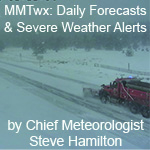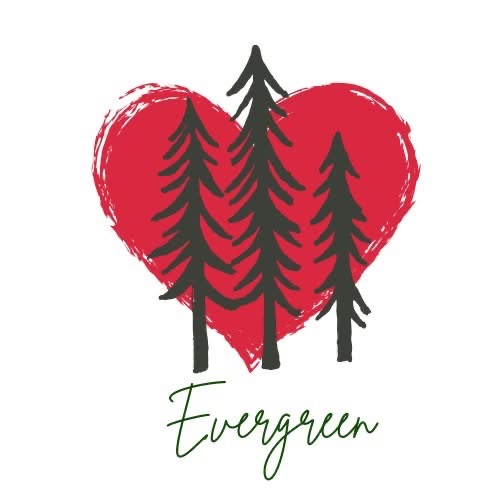- Posts: 28
- Thank you received: 7
Red Cross Avalanche & Mud Slide Safety Tips
- sweetiepie648
-
 Topic Author
Topic Author
- Leaf Peeper
-

Less
More
21 Dec 2017 13:03 #1
by sweetiepie648
Red Cross Avalanche & Mud Slide Safety Tips was created by sweetiepie648
Sharing Red Cross Safety Tips
Avalanche and Mudslides
Volunteer Michelle Adams
Avalanche Safety :cold:
1. PREPARE: You need a buddy, a beacon (worn over your mid layer, not in your pack), a shovel, a probe. And pack a puffy jacket
and a fire starter.
2. PRACTICE: Before heading out, have your buddy put his beacon inside a pack and bury it (at least three feet down), pinpoint its
location with your transceiver and probe, then start digging. Another option is to head to one of 37 U.S. resorts that have beacon-
training parks.
3. PAY ATTENTION: Avalanche advisories (avalanche.org) are generalized, and wind, temperature change, and snowfall can alter snowpack
stability within hours. Look for recent avalanche activity, collapsing or cracking snow, and other warnings. If you're skiing along
flat terrain and the snow makes a whumph sound, Mother Nature just told you to go home.
4. WORK TOGETHER: Travel one at a time on 25-degree or steeper slopes, and leapfrog down mountainsides so you keep each other within
sight. Don't underestimate small slopes; they can slide. Make sure everyone knows the slope's escape routes. Wait for each other out
of a potential slide's pathway.
5. MOVE FAST: If an avalanche strikes, try to ski out of its way. If it hits you, fight to get one hand out of the snow and wave your
other hand in front of your face to create an air pocket. If your buddy gets hit, note where he disappears and start searching below
that spot. Look for obvious clues: gloves or a pack. He has a 92 percent chance of survival if he is uninjured and you rescue him
within 15 minutes. The clock is ticking.
WHAT TO DO IF YOU'RE CAUGHT IN AN AVALANCHE
While the avalanche is moving:
Yell—let your partner know you’re caught
Try to escape off the slab
If you can’t get off the slab, get rid of your equipment
Use your breathing equipment (such as an Avalung mouthpiece, avalanche balloon or avalanche ball) or cover your mouth with your
clothing
Leave your pack on: (1.) It provides valuable padding to your back and kidneys; ( 2.) Should you survive, it contains needed
supplies; (3.) It makes you a larger object, possibly keeping you near the surface
Fight for your life—swimming or rolling like a log can help
As the avalanche comes to a stop: (1.) Keep one hand near your mouth to scoop out an air space and wiggle to make an air space
around your body; (2.) To help rescuers find you, extend a hand toward the surface before the avalanches comes to a stop (once it
stops, it will set up like concrete)
When the avalanche comes to a stop: Relax. The snow instantly freezes up like concrete, so most completely buried victims can’t
even move their fingers—there’s nothing more you can do so try to relax.
Equipment considerations:
Snow mobilers: Wear a helmet with a face shield and a good seal around the neck. It helps to maintain an air space around your head
when buried. Also, carry a shovel on your back in a small pack instead of on the snowmobile. If you survive and your snowmobile is
buried, you’ll need a shovel to dig out your friends.
Skiers: Wear releasable bindings and don’t use pole straps.
Snowboarders: Rig your bindings with a ripcord so you can get out of your snowboard in a hurry.
Specialty Avalanche Survival Gear
Avalanche Transceiver:
Avalanche rescue beacons (also called transceivers or locators) have proven to be the only reliable way to locate a completely buried
victim in time to save their life. Each person wears a transmitting beacon, and if someone is buried, the surviving members turn
their beacons to receive and they can quickly locate the buried victim.
AvaLung can increase that time up to an hour. Along with a beacon, the AvaLung is an important piece of life-saving equipment. The
AvaLung (in a vest, a over-the-chest sling, or build into a pack) offers critical oxygen intake that buys you precious time while
buried under snow. Designed to extract air from the snow, it works to redirect carbon dioxide away from your oxygen-intake zone,
reducing ice masking and CO2 poisoning of your oxygen supply.
Air Bag Pack:
Admit it. When you go to a party, you gently shake the bowl of potato chips so that the largest ones rise to the surface. Similarly,
larger objects tend to rise to the surface of avalanche debris. By pulling a rip cord, the avalanche air bag in your pack adds 150
liters or more to your volume. Used for over ten years in Europe, the statistics are impressive, roughly doubling your chances of
surviving an avalanche. The air bag system is now available in North America and it is rapidly gaining popularity. As prices and
weight continue to drop, the air bag will most likely become standard equipment for all backcountry travelers.
Landslide Safety
Landslides have occurred in almost every state and can cause significant damage
The term landslide describes downhill earth movements that can move slowly and cause damage gradually, or move rapidly,
destroying property and taking lives suddenly and unexpectedly. Most landslides are caused by natural forces or events,
such as heavy rain and snow melt, shaking due to earthquakes, volcanic eruptions and gravity. Landslides are typically
associated with periods of heavy rainfall or rapid snow melt and tend to worsen the effects of flooding. Areas burned by
forest and brush fires are also particularly susceptible to landslides.
Landslides generally happen in areas where they have occurred in the past. Learn about your area’s landslide risk. Landslides
can also be referred to as mudslides, debris flows, mud flows or debris avalanches.
Debris flows and other landslides onto roadways are common during rainstorms.
Heavily saturated ground is very susceptible to mud flows and debris flows.
Be aware that, generally, landslide insurance is not available, but that debris flow damage may be covered by flood insurance
policies from the National Flood Insurance Program.
Before
Prepare in Advance
Be sure you’re Red Cross Ready. That means:
Assembling an emergency preparedness kit.
Creating a household evacuation plan that includes your pets.
Staying informed about your community’s risk and response plans.
Educating your family on how to use the Safe and Well website.
Download the Emergency App for iPhone >> or for Android >>
What should I do if I live in an area at risk from landslides?
Learn about local emergency response and evacuation plans.
Talk to everyone in your household about what to do if a landslide occurs.
Create and practice an evacuation plan for your family and your business.
Assemble and maintain an emergency preparedness kit.
Become familiar with the land around where you live and work so that you understand your risk in different situations.
Watch the patterns of storm water drainage on slopes near your home, especially where runoff water converges.
Create and practice an evacuation plan for your family and your business.
Assemble and maintain an emergency preparedness kit.
During
What should I do if a landslide is occurring or likely to occur?
If you suspect imminent danger, evacuate immediately. Inform affected neighbors if you can, and contact your public works,
fire or police department.
Listen for unusual sounds that might indicate moving debris, such as trees cracking or boulders knocking together.
If you are near a stream or channel, be alert for any sudden increase or decrease in water flow and notice whether the water
changes from clear to muddy. Such changes may mean there is debris flow activity upstream so be prepared to move quickly.
Be especially alert when driving— watch for collapsed pavement, mud, fallen rocks and other indications of possible debris flow.
If you are ordered or decide to evacuate, take your animals with you.
Consider a precautionary evacuation of large or numerous animals as soon as you are aware of impending danger.
During Severe Storms
Stay alert and awake. Many deaths from landslides occur while people are sleeping.
Listen to local news stations on a battery-powered radio for warnings of heavy rainfall.
Consider leaving if it is safe to do so.
After
What should I do after a landslide?
Stay away from the slide area. There may be danger of additional slides.
Check for injured and trapped persons near the slide, without entering the direct slide area. Direct rescuers to their locations.
Help a neighbor who may require special assistance--infants, elderly people, and people with disabilities. Elderly people and people
with disabilities may require additional assistance. People who care for them or who have large families may need additional
assistance in emergency situations.
Listen to local radio or television stations for the latest emergency information.
Watch for flooding, which may occur after a landslide or debris flow. Floods sometimes follow landslides and debris flows because
they may both be started by the same event.
Look for and report broken utility lines to appropriate authorities. Reporting potential hazards will get the utilities turned
off as quickly as possible, preventing further hazard and injury.
Check the building foundation, chimney, and surrounding land for damage. Damage to foundations, chimneys, or surrounding land may
help you assess the safety of the area.
Replant damaged ground as soon as possible since erosion caused by loss of ground cover can lead to flash flooding.
Seek the advice of a geotechnical expert for evaluating landslide hazards or designing corrective techniques to reduce landslide
risk. A professional will be able to advise you of the best ways to prevent or reduce landslide risk, without creating further
hazard.
Avalanche and Mudslides
Volunteer Michelle Adams
Avalanche Safety :cold:
1. PREPARE: You need a buddy, a beacon (worn over your mid layer, not in your pack), a shovel, a probe. And pack a puffy jacket
and a fire starter.
2. PRACTICE: Before heading out, have your buddy put his beacon inside a pack and bury it (at least three feet down), pinpoint its
location with your transceiver and probe, then start digging. Another option is to head to one of 37 U.S. resorts that have beacon-
training parks.
3. PAY ATTENTION: Avalanche advisories (avalanche.org) are generalized, and wind, temperature change, and snowfall can alter snowpack
stability within hours. Look for recent avalanche activity, collapsing or cracking snow, and other warnings. If you're skiing along
flat terrain and the snow makes a whumph sound, Mother Nature just told you to go home.
4. WORK TOGETHER: Travel one at a time on 25-degree or steeper slopes, and leapfrog down mountainsides so you keep each other within
sight. Don't underestimate small slopes; they can slide. Make sure everyone knows the slope's escape routes. Wait for each other out
of a potential slide's pathway.
5. MOVE FAST: If an avalanche strikes, try to ski out of its way. If it hits you, fight to get one hand out of the snow and wave your
other hand in front of your face to create an air pocket. If your buddy gets hit, note where he disappears and start searching below
that spot. Look for obvious clues: gloves or a pack. He has a 92 percent chance of survival if he is uninjured and you rescue him
within 15 minutes. The clock is ticking.
WHAT TO DO IF YOU'RE CAUGHT IN AN AVALANCHE
While the avalanche is moving:
Yell—let your partner know you’re caught
Try to escape off the slab
If you can’t get off the slab, get rid of your equipment
Use your breathing equipment (such as an Avalung mouthpiece, avalanche balloon or avalanche ball) or cover your mouth with your
clothing
Leave your pack on: (1.) It provides valuable padding to your back and kidneys; ( 2.) Should you survive, it contains needed
supplies; (3.) It makes you a larger object, possibly keeping you near the surface
Fight for your life—swimming or rolling like a log can help
As the avalanche comes to a stop: (1.) Keep one hand near your mouth to scoop out an air space and wiggle to make an air space
around your body; (2.) To help rescuers find you, extend a hand toward the surface before the avalanches comes to a stop (once it
stops, it will set up like concrete)
When the avalanche comes to a stop: Relax. The snow instantly freezes up like concrete, so most completely buried victims can’t
even move their fingers—there’s nothing more you can do so try to relax.
Equipment considerations:
Snow mobilers: Wear a helmet with a face shield and a good seal around the neck. It helps to maintain an air space around your head
when buried. Also, carry a shovel on your back in a small pack instead of on the snowmobile. If you survive and your snowmobile is
buried, you’ll need a shovel to dig out your friends.
Skiers: Wear releasable bindings and don’t use pole straps.
Snowboarders: Rig your bindings with a ripcord so you can get out of your snowboard in a hurry.
Specialty Avalanche Survival Gear
Avalanche Transceiver:
Avalanche rescue beacons (also called transceivers or locators) have proven to be the only reliable way to locate a completely buried
victim in time to save their life. Each person wears a transmitting beacon, and if someone is buried, the surviving members turn
their beacons to receive and they can quickly locate the buried victim.
AvaLung can increase that time up to an hour. Along with a beacon, the AvaLung is an important piece of life-saving equipment. The
AvaLung (in a vest, a over-the-chest sling, or build into a pack) offers critical oxygen intake that buys you precious time while
buried under snow. Designed to extract air from the snow, it works to redirect carbon dioxide away from your oxygen-intake zone,
reducing ice masking and CO2 poisoning of your oxygen supply.
Air Bag Pack:
Admit it. When you go to a party, you gently shake the bowl of potato chips so that the largest ones rise to the surface. Similarly,
larger objects tend to rise to the surface of avalanche debris. By pulling a rip cord, the avalanche air bag in your pack adds 150
liters or more to your volume. Used for over ten years in Europe, the statistics are impressive, roughly doubling your chances of
surviving an avalanche. The air bag system is now available in North America and it is rapidly gaining popularity. As prices and
weight continue to drop, the air bag will most likely become standard equipment for all backcountry travelers.
Landslide Safety
Landslides have occurred in almost every state and can cause significant damage
The term landslide describes downhill earth movements that can move slowly and cause damage gradually, or move rapidly,
destroying property and taking lives suddenly and unexpectedly. Most landslides are caused by natural forces or events,
such as heavy rain and snow melt, shaking due to earthquakes, volcanic eruptions and gravity. Landslides are typically
associated with periods of heavy rainfall or rapid snow melt and tend to worsen the effects of flooding. Areas burned by
forest and brush fires are also particularly susceptible to landslides.
Landslides generally happen in areas where they have occurred in the past. Learn about your area’s landslide risk. Landslides
can also be referred to as mudslides, debris flows, mud flows or debris avalanches.
Debris flows and other landslides onto roadways are common during rainstorms.
Heavily saturated ground is very susceptible to mud flows and debris flows.
Be aware that, generally, landslide insurance is not available, but that debris flow damage may be covered by flood insurance
policies from the National Flood Insurance Program.
Before
Prepare in Advance
Be sure you’re Red Cross Ready. That means:
Assembling an emergency preparedness kit.
Creating a household evacuation plan that includes your pets.
Staying informed about your community’s risk and response plans.
Educating your family on how to use the Safe and Well website.
Download the Emergency App for iPhone >> or for Android >>
What should I do if I live in an area at risk from landslides?
Learn about local emergency response and evacuation plans.
Talk to everyone in your household about what to do if a landslide occurs.
Create and practice an evacuation plan for your family and your business.
Assemble and maintain an emergency preparedness kit.
Become familiar with the land around where you live and work so that you understand your risk in different situations.
Watch the patterns of storm water drainage on slopes near your home, especially where runoff water converges.
Create and practice an evacuation plan for your family and your business.
Assemble and maintain an emergency preparedness kit.
During
What should I do if a landslide is occurring or likely to occur?
If you suspect imminent danger, evacuate immediately. Inform affected neighbors if you can, and contact your public works,
fire or police department.
Listen for unusual sounds that might indicate moving debris, such as trees cracking or boulders knocking together.
If you are near a stream or channel, be alert for any sudden increase or decrease in water flow and notice whether the water
changes from clear to muddy. Such changes may mean there is debris flow activity upstream so be prepared to move quickly.
Be especially alert when driving— watch for collapsed pavement, mud, fallen rocks and other indications of possible debris flow.
If you are ordered or decide to evacuate, take your animals with you.
Consider a precautionary evacuation of large or numerous animals as soon as you are aware of impending danger.
During Severe Storms
Stay alert and awake. Many deaths from landslides occur while people are sleeping.
Listen to local news stations on a battery-powered radio for warnings of heavy rainfall.
Consider leaving if it is safe to do so.
After
What should I do after a landslide?
Stay away from the slide area. There may be danger of additional slides.
Check for injured and trapped persons near the slide, without entering the direct slide area. Direct rescuers to their locations.
Help a neighbor who may require special assistance--infants, elderly people, and people with disabilities. Elderly people and people
with disabilities may require additional assistance. People who care for them or who have large families may need additional
assistance in emergency situations.
Listen to local radio or television stations for the latest emergency information.
Watch for flooding, which may occur after a landslide or debris flow. Floods sometimes follow landslides and debris flows because
they may both be started by the same event.
Look for and report broken utility lines to appropriate authorities. Reporting potential hazards will get the utilities turned
off as quickly as possible, preventing further hazard and injury.
Check the building foundation, chimney, and surrounding land for damage. Damage to foundations, chimneys, or surrounding land may
help you assess the safety of the area.
Replant damaged ground as soon as possible since erosion caused by loss of ground cover can lead to flash flooding.
Seek the advice of a geotechnical expert for evaluating landslide hazards or designing corrective techniques to reduce landslide
risk. A professional will be able to advise you of the best ways to prevent or reduce landslide risk, without creating further
hazard.
Please Log in or Create an account to join the conversation.
Time to create page: 0.135 seconds





